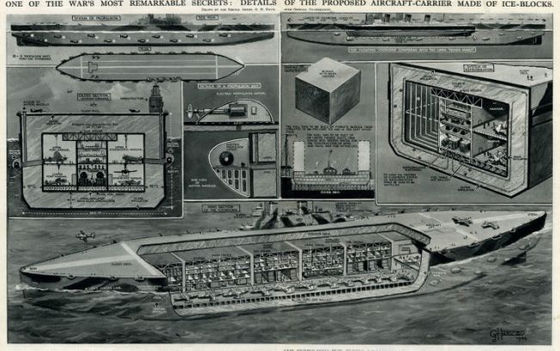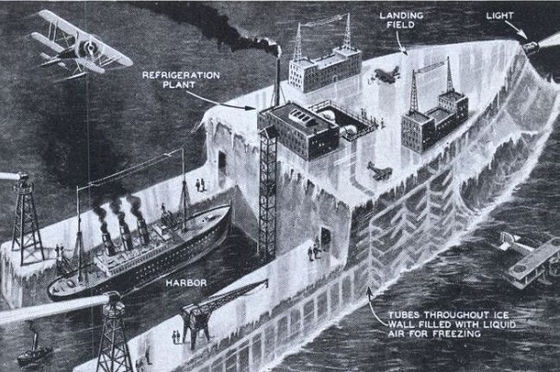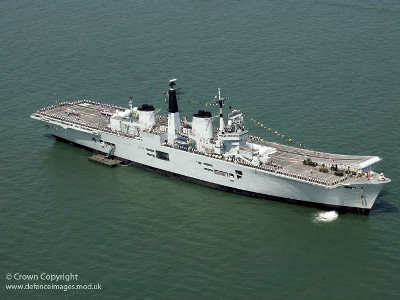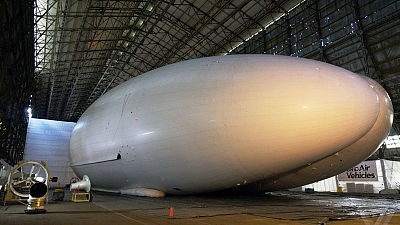What is Project Habakuk, the secret plan to build an unsinkable aircraft carrier out of giant pieces of ice?

In the 1940s, a British plan was launched to use ice as a material for the hull of a ship instead of the scarce steel and aluminum. The 99% Invisible podcast series introduced the failed 'Habakkuk Project,' which was expected to create a virtually unsinkable aircraft carrier, due to its hull over a mile long (about 1.6 km) and the idea that it could be repaired using water, which is available everywhere.
Project Habbakuk: Britain's Secret Ice 'Bergship' Aircraft Carrier Project - 99% Invisible
In the midst of World War II, German submarines, known as U-boats, caused great damage to the Allied powers, including Great Britain, and the Allies were looking for ways to counter Germany. In the midst of this, Geoffrey Pike , an inventor working for the British Combined Forces Command, came up with the idea of a mobile, unsinkable aircraft carrier made of ice.
Pike envisioned a 'massive aircraft-carrying ship, over a mile long, with a sturdy hull made of ice. With a long flight deck on top and a huge cavity underneath to house aircraft, the design would be the largest vehicle ever built on land or water. It was a bold idea to reduce the consumption of steel and aluminum, which were in short supply at the time, and to build it primarily out of ice, which was readily available.
When completed, the ship was expected to have a range of 7,000 miles (about 11,300 km) and be capable of supporting heavy bombers, with a length of over a mile and a weight of 2.2 million tons.

Pike was not the first to come up with the idea of using ice as a ship's hull, but it had never been done before because ice is brittle and melts easily, and its density poses the risk of capsizing.
To solve these existing problems, Pike came up with a composite material called '
The sheer scale and audacity of the project meant it needed a name to match its incredible scale, so the Royal Navy named the Pike aircraft carrier project 'Project Habbakuk,' after a passage from the Book of Habakkuk in the Hebrew Bible : 'Behold, and behold, O people of the nations, I will do a thing in your days, which you will not believe, even if you were told it.' However, this is said to have been a misspelling of 'Habakkuk.'
A prototype was ordered in 1943, and a 30-foot by 60-foot, 1,000-ton model was completed in Canada. The prototype used at least 300,000 tons of wood pulp, 25,000 tons of insulation, 35,000 tons of wood, and 10,000 tons of steel, and the hull was designed to be capable of freezing water in the summer with only a one-horsepower motor.

Project Habakuk seemed to be on track, but calculations revealed that more insulation and steel were needed, new airfields reduced the need for aircraft carriers, improvements to fuel tanks extended the range of aircraft, and the estimated cost of £10 million (approximately 50 billion yen at the time) was deemed too high for an experimental aircraft. As a result, the project was cancelled and the mythical iceberg carrier was never deployed in combat.
Still, the prototype showed its feasibility, surviving three hot Canadian summers before the hull melted completely. The wreckage is located at the bottom of Lake Patricia in Jasper National Park, Alberta, Canada, where the prototype was tested, and a plaque was installed at the bottom by divers from the Alberta Underwater Archaeology Society in 1988.

Related Posts:
in Vehicle, Posted by log1p_kr







